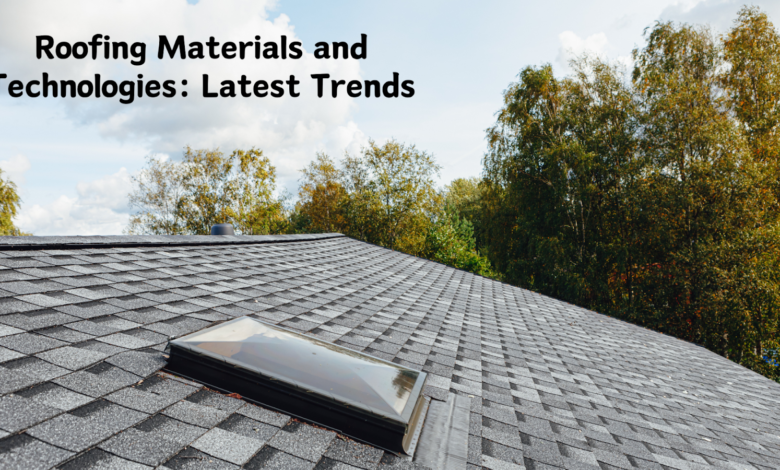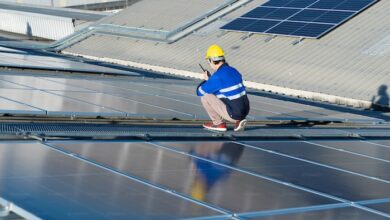Roofing Materials and Technologies: Latest Trends

The roof is one of the most important components of any building, providing critical protection from the elements. As a result, the roofing industry is evolving to develop advanced materials and harness new technologies. This article explores the most significant innovations transforming roofing in 2024 and beyond.
Advanced Roofing Materials
In response to growing demands for energy efficiency, sustainability, resilience, and longevity. They’re pioneering new roofing materials using advanced nanotech and engineering that reimagines possibilities.
For contractors in rainy regions like Portland and beyond, staying on top of the latest material becomes essential. Roofing contractors in Portland, OR, are incorporating these latest trends to offer homeowners. They provide businesses with solutions that not only enhance the aesthetic appeal of structures. Also, contribute to long-term sustainability and energy efficiency.
- Solar-reflective roofing can reduce cooling costs by up to 30%, according to the U.S. Department of Energy. These cool materials use specialized paints, membranes, or tiles containing reflective pigments that reflect sunlight and absorb less heat than traditional dark roofs.
- Green roofing provides insulation and stormwater management benefits, increasing energy efficiency by 200-500%, as per Green Roofs for Healthy Cities. Vegetated roofing systems with lightweight soil and hardy plants help manage rainfall, reduce urban heat, and provide habitat.
- Plastic and synthetic rubber composites like thermoplastic olefin (TPO) are gaining popularity as durable, resilient roofing materials with a lifespan exceeding 50 years, according to the Synthetic Roofing Materials Association. Their seamless waterproof membranes stand up to extreme weather.
- Impact-resistant and hail-proof options, such as textured metal shingles, asphalt shingles reinforced with polymer fibers, and thick concrete tiles, offer protection against severe storms, withstanding winds up to 130 mph and hail up to 2 inches.
- Cool color technology applies reflective pigments to darker shingles for both heat mitigation and aesthetic versatility.
- Transparent solar panels can be installed over glass skylights to generate power while still transmitting light.
- Light-diffusing fiberglass skylights illuminate interiors with natural light while minimizing heat gain and glare.
- Anti-microbial copper roofing components use copper’s natural disinfectant properties for medical and food processing facilities.
Continued material science innovations will yield roofing solutions to fit any need – from managing stormwater to powering buildings to surviving the most extreme weather events.
Technological Advancements
Exciting technologies are transforming roofing installation, maintenance, and efficiency. According to Roofing Contractor Magazine, smart roofing systems with interconnected sensors and controls can reduce energy consumption by 20%. Drones allow for rapid and low-cost aerial roof inspections, reducing inspection time by 90% as per Construction Dive.
3D printing of customized roofing elements results in 60% less waste during production, as reported by Deloitte. Simulation software enables efficient modeling of factors like snow load and drainage. Together, these innovations enable smarter, more sustainable roofing.
Sustainable Roofing Practices
Sustainability is a top priority, with conscious solutions growing in popularity. The Environmental Protection Agency states that green roofs can absorb 70-90% of rainwater, reducing runoff.
Demand for recycled roofing materials is predicted to expand by 6.5% according to Grand View Research. Many projects pursue LEED green building certification, which encourages sustainable roofs. The industry is embracing materials and designs that benefit the environment.
Energy Efficiency
Making buildings more energy efficient is a major priority driving roofing innovation.
- Cool roofing materials made with reflective pigments or coatings can lower rooftop temperatures by up to 50°F as per Lawrence Berkeley National Laboratory. This passive cooling effect decreases heat absorption and air conditioning demands.
- Solar photovoltaic systems integrated into shingles, tiles, or panels enable buildings to generate clean onsite power. According to the Solar Energy Industries Association, solar roofing installations grew 43% in 2021 as the technology became more accessible and affordable.
- Smart roofing systems can adjust shade coverings or airflow to optimize natural lighting and ventilation, while IoT-connected smart roofs can timely identify leaks or insulation deficiencies and dispatch alerts.
- Advanced thermal efficient insulation materials like aerogel reduce conductive and convective heat transfer through the roof. According to Energy.gov, improving roof insulation can lower heating and cooling costs by 20-30%.
- Passive solar building design positions roof overhangs, skylights, and other elements to heat and light interiors during winter while controlling heat gain in summer.
- Government incentives such as federal tax credits, state/local rebates, and performance payments provide more motivation to install energy-efficient roofing.
With energy conservation being a global priority, continued innovations to reduce roofing energy demands and even generate power will remain at the forefront.
Durability and Longevity
Durability is crucial for roofing longevity and value. As per Roofing Contractor Magazine, impact-resistant asphalt shingles and concrete tiles can withstand winds up to 130 mph. Advanced acrylic coatings can extend a roof’s lifespan by 15-20 years according to Roofing Insights.
Regular maintenance, like cleaning gutters, can add 50% to a roof’s lifespan. Materials built to withstand weathering, coated to resist damage, and cared for will keep buildings protected.
Cost-Effective Solutions
While sustainable roofs may cost more upfront, the U.S. Environmental Protection Agency estimates lifetime savings of up to $200,000. Solar roofing qualifies for incentives covering 30% of installation costs reports the Solar Energy Industries Association.
Financing options like Property Assessed Clean Energy (PACE) help manage costs. Ultimately, investing in durable, high-performance roofing drives significant long-term savings.
Real-World Success Stories
These trends are already yielding success. The Ford Dearborn Truck Plant added a sustainable vegetated roof, reducing stormwater runoff by 5 million gallons annually. The Empire State Building retrofitted 6,500 windows and coated its roof, cutting energy use by 40%. These projects exemplify how the latest in roofing benefits businesses.
FAQs
What is the cost difference between traditional and eco-friendly roofing?
Eco-friendly options often come with higher upfront costs but offer savings over their lifespan. Calculate lifetime costs when evaluating your choices.
What is involved in installing and maintaining a smart roof?
Installation typically takes 1-2 days. Maintenance needs vary by system but may include monitoring connected devices and optimizing energy settings.
Are there incentives for energy-efficient roofing?
Yes, federal tax credits and some state/local programs provide incentives for cool roofs, solar roofs, etc. Contact local utilities for details.
Conclusion
Understanding the latest materials and innovations lets architects, builders, and property owners make informed decisions about roofing’s exciting future. Knowing what’s emerging allows maximizing advantage from ongoing improvements. Staying trend on options allows the optimal roof or recommending the best upgrades for clients. Consult roofing experts to determine the best solutions for your roofing needs.



